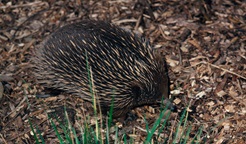Learn more
Learn more about why this park is special
Boyd River campground is in Kanangra-Boyd National Park. Here are just some of the reasons why this park is special:
Action adventure

Hardcore hiker? Mad for mountain biking? There's something for whatever level of adventure you desire. Fire trails that wind throughout the park can be explored by 4WD or bicycle. For those who are handy with a map and compass, there's plenty of opportunity for self-reliant bushwalking. There are also marked trails that take in the captivating landscape which are even suitable for the kids. You might even want to throw in a line at Kowmung River to see if you can hook a trout.
- Boyd River loop Take the easy route to peaceful cycling on Boyd River loop, a 21km journey that follows fire trails and roads in Kanangra-Boyd National Park.
- Kanangra-Boyd lookout You can see for miles at Kanangra-Boyd lookout, an easily accessible viewpoint overlooking Kanangra Walls and Mount Cloudmaker.
- Mount Emperor loop A scenic 12.5km ride across the Boyd Plateau, Mount Emperor loop gives mountain bike riders the opportunity to explore some of the lesser-known corners Kanangra-Boyd National Park.
Amazing formations

You can see many unique formations in Kanangra-Boyd National Park, including Thurat Spires, Kanangra Walls, Mount Colong, and waterfall systems - Kalang, Kanangara and Morong. The park also features a series of karst landforms that can be explored by those with caving experience.
- Kalang Falls walk Kalang Falls walk in Kanangra-Boyd National Park offers marvellous views of the cascading water at Kanangra and Kalang Falls.
- Kanangra-Boyd lookout You can see for miles at Kanangra-Boyd lookout, an easily accessible viewpoint overlooking Kanangra Walls and Mount Cloudmaker.
Preserving nature for future generations

There was a time when Kanangra-Boyd was in danger from logging and the extraction of lime. That all changed after a five-year conservation effort resulted in it being declared part of Greater Blue Mountains Area World Heritage Property in 1972.
Wonderful wilderness

High plateaus and sheltered slopes mean Kanangra-Boyd has a diverse range of plantlife, some of it unique to the national park. Heath and mallee dominate the areas exposed to wind and weather, while tall snow gum forests can also be found in the park. Look for the yellow Kanangra wattle that grows only on the rivers - it flowers from early spring to late winter. The wildlife population is extensive too. Keep your eyes peeled for red-necked wallabies, which thrive in this area. Honeyeaters, wrens and fruit-eating pigeons are just some of the 195 species of birds that can be spotted in the park on a daily basis.
- Kalang Falls walk Kalang Falls walk in Kanangra-Boyd National Park offers marvellous views of the cascading water at Kanangra and Kalang Falls.
- Kanangra-Boyd lookout You can see for miles at Kanangra-Boyd lookout, an easily accessible viewpoint overlooking Kanangra Walls and Mount Cloudmaker.
Plants and animals protected in this park
Animals
-

Spotted-tailed quoll (Dasyurus maculatus)
The spotted-tailed quoll is the largest remaining carnivorous marsupial on the Australian mainland. It’s protected as a vulnerable species in NSW.
-

Short-beaked echidna (Tachyglossus aculeatus)
One of only 2 egg-laying mammals in the world, the short-beaked echidna is one of the most widespread of Australian native animals. Covered in spines, or quills, they’re equipped with a keen sense of smell and a tube-like snout which they use to break apart termite mounds in search of ants.
-

Superb lyrebird (Menura novaehollandiae)
With a complex mimicking call and an elaborate courtship dance to match, the superb lyrebird is one of the most spectacular Australian animals. A bird watching must-see, the superb lyrebird can be found in rainforests and wet woodlands across eastern NSW and Victoria.
Look out for...
Short-beaked echidna
Tachyglossus aculeatus

One of only 2 egg-laying mammals in the world, the short-beaked echidna is one of the most widespread of Australian native animals. Covered in spines, or quills, they’re equipped with a keen sense of smell and a tube-like snout which they use to break apart termite mounds in search of ants.
